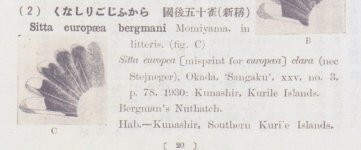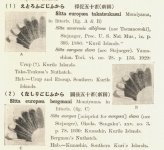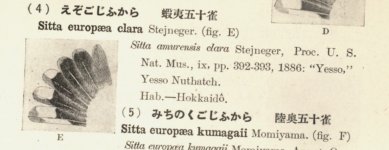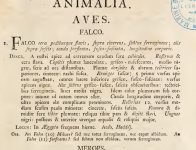Björn Bergenholtz
(former alias "Calalp")

I have some questions regarding some synonyms (all eponyms, all commemorating Swedish guys) ... this as there are different bids or contradictory claims (alt. different opinions) in various references.
So what about ...
arrhenii as in:
• "Neocossyphus rufus arrhenii" LÖNNBERG 1917 (here) ... equal of; nominate Neocossyphus rufus rufus FISCHER & REICHENOW 1884 or N. rufus gabunensis NEUMANN 1908 ... ?
bergmani as in:
• "Sitta europaea bergmani" MOMIYAMA 1931 (OD attached)... equal of; Sitta europaea baicalensis TACZANOWSKI 1882 or S. e. clara STEJNEGER 1887 or ... ?
Note that the OD tells us "(nec Stejneger)". Is it possibly equal of yet another one of today's subspecies ... ? Maybe Sitta europaea asiatica GOULD 1835 ... ?
forskahlii as in:
• "[Falco] Forskåhlii" GMELIN 1788 (here) ... equal of; Milvus milvus LINNAEUS 1758 or Milvus (migrans) aegyptius GMELIN 1788 ... ?
To me it looks like the latter! (... luckily, regarding precedence/priority, described two pages earlier )
)
Anyone know the most recent findings/conclusions?
If any reply, please state according to what list/taxonomy.
Grateful for all the help I can get!
Björn (... following the IOC list)
--
So what about ...
arrhenii as in:
• "Neocossyphus rufus arrhenii" LÖNNBERG 1917 (here) ... equal of; nominate Neocossyphus rufus rufus FISCHER & REICHENOW 1884 or N. rufus gabunensis NEUMANN 1908 ... ?
bergmani as in:
• "Sitta europaea bergmani" MOMIYAMA 1931 (OD attached)... equal of; Sitta europaea baicalensis TACZANOWSKI 1882 or S. e. clara STEJNEGER 1887 or ... ?
Note that the OD tells us "(nec Stejneger)". Is it possibly equal of yet another one of today's subspecies ... ? Maybe Sitta europaea asiatica GOULD 1835 ... ?
forskahlii as in:
• "[Falco] Forskåhlii" GMELIN 1788 (here) ... equal of; Milvus milvus LINNAEUS 1758 or Milvus (migrans) aegyptius GMELIN 1788 ... ?
To me it looks like the latter! (... luckily, regarding precedence/priority, described two pages earlier
Anyone know the most recent findings/conclusions?
If any reply, please state according to what list/taxonomy.
Grateful for all the help I can get!
Björn (... following the IOC list)
--
Attachments
Last edited:










